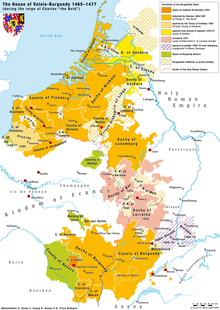Treaty of Arras (1482)
This article needs additional citations for verification. (February 2023) |

The Treaty of Arras was signed at
Louis XI of France and Archduke Maximilian I of Habsburg as heir of the Burgundian Netherlands in the course of the Burgundian
succession crisis.
The dukes from the
Burgundy proper, Flanders, Artois and the Picardy were seized as reverted fiefs[1] by the French king. Before his death however, Charles had arranged with Emperor Frederick III of Habsburg the marriage of their children Mary the Rich
and Archduke Maximilian, which took place on 19 August 1477.
Maximilian did not hesitate to defend the heritage of his wife, culminating in the 1479
Archduchess Margaret of Austria, to the Dauphin of France, the later King Charles VIII, bringing the Imperial County of Burgundy to the French crown as her dowry. France retained most of its Burgundian fiefdoms except for the affluent County of Flanders, which passed to Maximilian (but soon rebelled against the archduke
).
Although the betrothal was later renounced and Charles VIII would marry Duchess
Charolais
and Artois.
References
- ^ Saenger, Paul. “Burgundy and the Inalienability of Appanages in the Reign of Louis XI.” French Historical Studies, vol. 10, no. 1, 1977, pp. 1–26. JSTOR, https://doi.org/10.2307/286114. Accessed 3 Feb. 2023.
